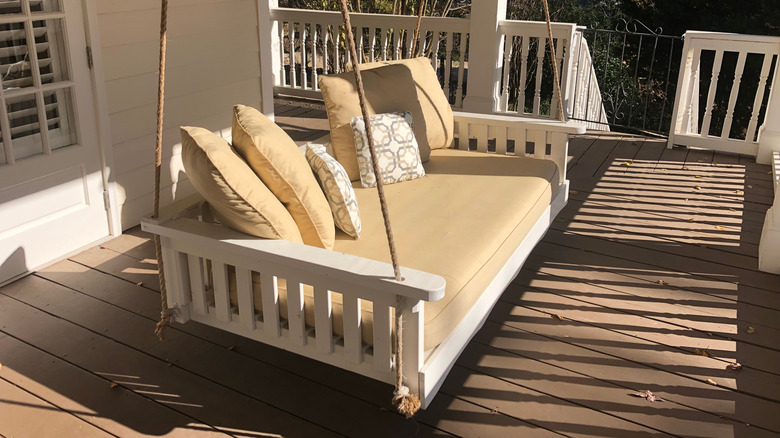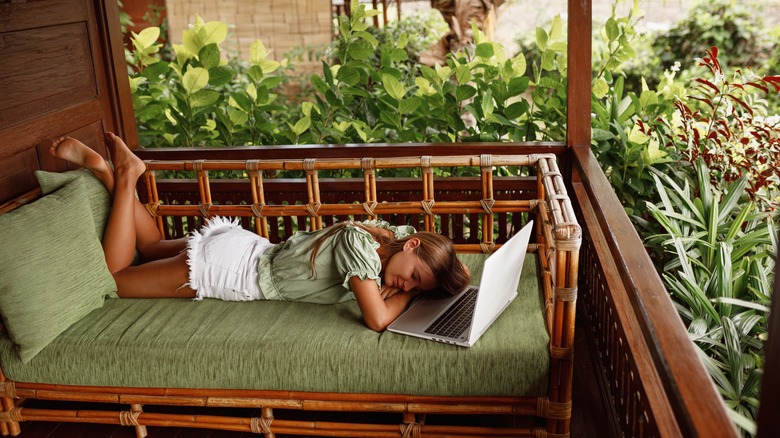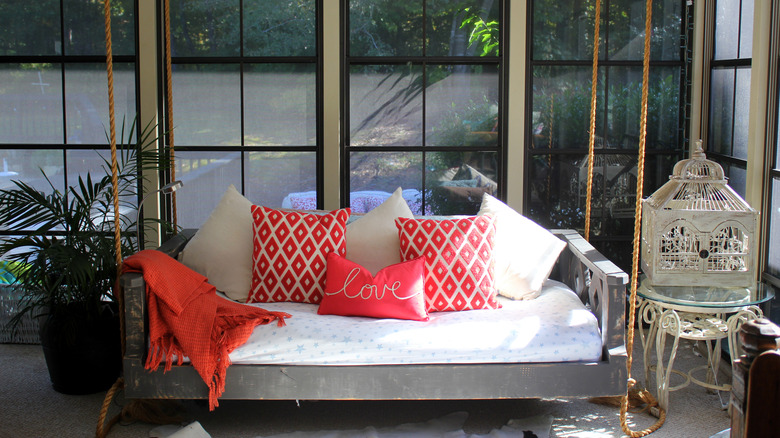How To Pick The Best Bed For Your Sleeping Porch This Summer
A sleeping porch is one of the most enjoyable home features to have during the summer months, offering a comfortable space to kick back, relax, take a nap, or even spend the night semi-outdoors. Before air conditioning was invented, sleeping porches once served an important purpose, allowing families to escape from the stuffy heat and sleep in the cool breeze on summer nights. Today, they conjure up memories of summer camp cabins, reading by flashlight, and waking up to birdsong and the aroma of cooking bacon. But no ordinary mattress will do — porch beds need to be able to withstand the elements and avoid being ruined by water, dirt, or mold. To choose the perfect sleeping porch bed, you'll need to factor in the design of your outdoor living space, the durability of the materials, and the adaptability of the bed.
Of course, if all you wanted was a practical spot to nap, you could pull up a cot or hammock. However, a sleeping porch bed must be more than just bare bones — it also has to look appealing, add value to your space, and enrich your outdoor experience. Here's everything you need to know about choosing a dreamy and durable bed for your outdoor oasis, and some design tips that will make you want to spend every night out with the fireflies.
Planning the placement, size, and style
The type of porch bed you should choose depends greatly on the size and setup of your sleeping porch. The bed should be located in a place where it won't be affected by rain and dirt — at least not often. If you have glass windows surrounding your sleeping porch, for example, you can place the bed much closer to the windows and keep them shut on rainy days. However, if you have a screened porch or open patio, you may want to put the bed against the wall, where it's sheltered. Remember that prevailing winds in the U.S. tend to blow from west to east, so place your bed where you can catch a good breeze!
Location will determine the size and style of bed that's best for you, whether that be a freestanding daybed, a hanging bed, or one that folds up against the wall. The size and style of the bed you choose can also impact its adaptability, so think carefully about how you'll use the space. Do you want to be able to remove the bed during winter? Is this where you plan to sleep all summer, or is it just temporary a place to relax in the afternoons? For more permanent sleeping arrangements, you could even install a porch swing. If you're just planning to relax outside temporarily, a lightweight daybed or cot is ideal because it can be easily broken down and moved.
Balancing function with aesthetics
A good porch bed is an investment, so consider the aesthetic value that it brings to your whole space — a hefty hanging bed feels luxurious and comfortable, while a daybed or sleeping bench can bring more of a classic camping vibe. After you've settled on a solid bed location and construction style, you'll also need to think about the details of the bed design. A breathable, water-and-UV-resistant fabric material like polypropylene is the best choice for outdoor mattresses. For easy cleaning, choose a mattress with a zip-off cover, and to keep it in tip-top shape, remember to bring it inside during heavy downpours.
The key to making sleeping porches feel fun and relaxing is to style them much like you would an ordinary bedroom. Opt for soft, soothing colors and minimal furniture. Add a nightstand beside the bed for a soft lantern, hang string lights for a cozy effect, and arrange live plants around the space to incorporate the outdoors. While the bed itself should be weather-resistant, decorating is where you can play with soft textures. Cover your polypropylene mattress with soft cotton or linen sheets, a lightweight comforter, plush pillows, and your favorite throw blankets. Just remember to bring them back inside after your nap!


